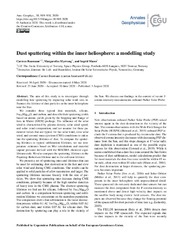| dc.contributor.author | Baumann, Carsten | |
| dc.contributor.author | Myrvang, Margaretha | |
| dc.contributor.author | Mann, Ingrid | |
| dc.date.accessioned | 2020-08-21T07:29:10Z | |
| dc.date.available | 2020-08-21T07:29:10Z | |
| dc.date.issued | 2020-08-03 | |
| dc.description.abstract | The aim of this study is to investigate how sputtering by impacting solar wind particles influence the lifetime of dust particles in the inner heliosphere near the Sun.<p><p>
We consider three typical dust materials: silicate, Fe<sub>0.4</sub>Mg<sub>0.6</sub>O and carbon and describe their sputtering yields based on atomic yields given by the Stopping and Range of Ions in Matter (SRIM) package. The influence of the solar wind is characterized by plasma density, solar wind speed and solar wind composition and we assume for these parameters values that are typical for fast solar wind, slow solar wind and CME conditions to calculate the sputtering lifetimes of dust. To compare the sputtering lifetimes to typical sublimation lifetimes we use temperature estimates based on Mie calculations and material vapour pressure derived with the chemical equilibrium code MAGMA. We also compare the sputtering lifetimes to the Poynting-Robertson lifetime and to the collision lifetime.<p><p>
We present a set of sputtering rates and lifetimes that can be used for estimating dust destruction in the fast and slow solar wind and during CME conditions. Our results can be applied to solid particles of a few nm and larger. The sputtering lifetimes increase linearly with size of particles. We show that sputtering rates increase during CME conditions, primarily because of the high number densities of heavy ions in the CME plasma. The shortest sputtering lifetimes we find are for silicate, followed by Fe<sub>0.4</sub>Mg<sub>0.6</sub>O and carbon. In a comparison between sputtering and sublimation lifetimes we concentrate on the nanodust population. The comparison shows that sublimation is the faster destruction process within 0.1 AU for Fe<sub>0.4</sub>Mg<sub>0.6</sub>O, within 0.05 AU for carbon dust and within 0.07 AU for silicate dust. The destruction by sputtering can play a role in the vicinity of the Sun. We discuss our findings in the context of recent F-corona intensity measurements onboard Parker-Solar-Probe. | en_US |
| dc.identifier.citation | Baumann, Myrvang, Mann. Dust sputtering within the inner heliosphere. Annales Geophysicae. 2020 | en_US |
| dc.identifier.cristinID | FRIDAID 1818681 | |
| dc.identifier.doi | https://doi.org/10.5194/angeo-38-919-2020 | |
| dc.identifier.issn | 0992-7689 | |
| dc.identifier.issn | 1432-0576 | |
| dc.identifier.uri | https://hdl.handle.net/10037/19084 | |
| dc.language.iso | eng | en_US |
| dc.publisher | Copernicus Publications | en_US |
| dc.relation.journal | Annales Geophysicae | |
| dc.relation.projectID | Norges forskningsråd: 262941 | en_US |
| dc.relation.projectID | info:eu-repo/grantAgreement/RCN/ROMFORSK/262941/Norway/Cosmic dust in the solar-terrestrial physics: exploring the inner heliosphere// | en_US |
| dc.rights.accessRights | openAccess | en_US |
| dc.rights.holder | Copyright 2020 The Author(s) | en_US |
| dc.subject | VDP::Mathematics and natural science: 400 | en_US |
| dc.subject | VDP::Matematikk og Naturvitenskap: 400 | en_US |
| dc.title | Dust sputtering within the inner heliosphere: a modelling study | en_US |
| dc.type.version | publishedVersion | en_US |
| dc.type | Journal article | en_US |
| dc.type | Tidsskriftartikkel | en_US |
| dc.type | Peer reviewed | en_US |


 English
English norsk
norsk